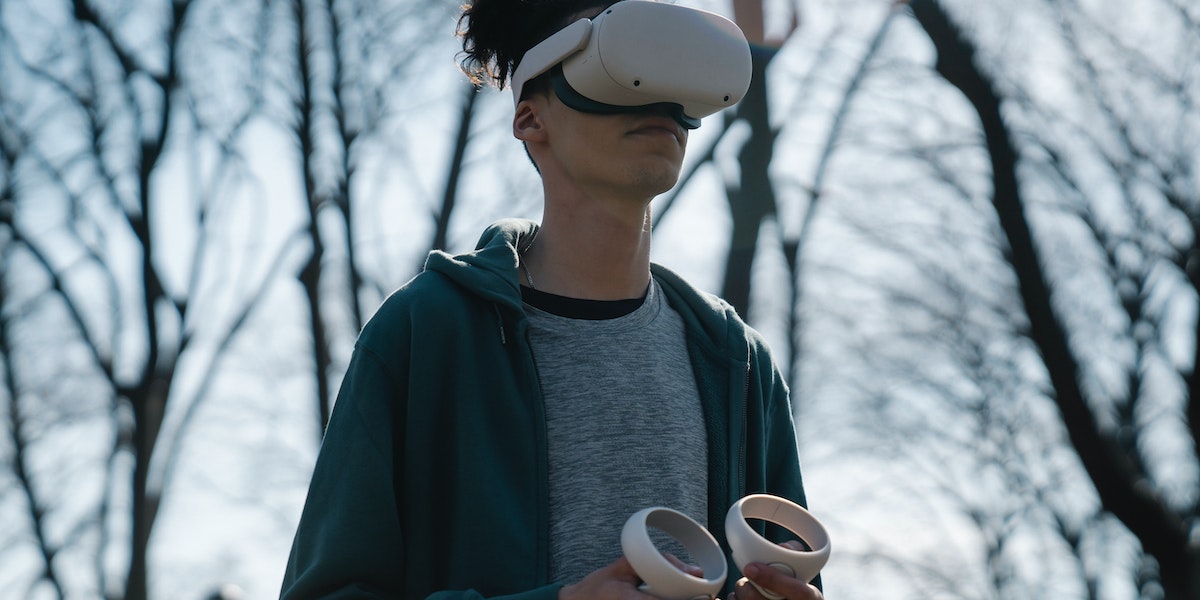
Transcending Reality: The Impact and Potential of Virtual Reality Technology
- By PurushottamRaj Gaurav
- 03-02-2023
- Virtual Reality
Virtual reality (VR) technology has been in development since the 1950s, but it wasn't until the 1990s that it became widely available to consumers. Early VR systems were primarily used for flight simulation and military training. In the 1960s, Ivan Sutherland, a computer scientist and one of the pioneers of computer graphics, developed the "Ultimate Display," a head-mounted device that allowed users to experience a virtual environment.
In the 1980s and 1990s, companies such as VPL Research and Sega began developing and selling VR systems for gaming and entertainment. However, these early systems were expensive and not widely adopted by consumers.
In the 2010s, advances in technology, including the development of smartphones and faster processors, made VR more accessible and affordable. In 2012, Oculus VR, a company founded by Palmer Luckey, developed the Oculus Rift, a popular VR headset that was later acquired by Facebook.
In recent years, VR technology has been used in a variety of industries, including gaming, education, and healthcare. The use of VR in gaming has grown and also it's been used in areas like tourism, real estate, and even therapy and training. VR technology is continuously evolving and new applications are being developed all the time.
The current state of Virtual Reality technology:
Virtual Reality (VR) technology has advanced significantly in recent years, with the development of more advanced and affordable VR headsets and software. VR technology allows users to immerse themselves in a digital environment, and it has a wide range of applications, including gaming, education, and therapy. Some popular VR headsets currently on the market include the Oculus Quest 2, the Valve Index, and the PlayStation VR. VR technology is also being used in a variety of industries, such as automotive, architecture, and real estate. Technology is still developing and advancing, and new uses for VR are constantly being discovered.
Types of Virtual Reality
1. Non-Immersive VR
Non-immersive virtual reality (VR) refers to VR technology that does not fully envelop the user in a simulated environment. This can include experiences that are displayed on a computer screen or mobile device, or through a head-mounted display (HMD) that only partially blocks out the user's view of the real world. Non-immersive VR can also include augmented reality (AR) experiences, which blend virtual elements with the user's view of the real world. Non-immersive VR is typically less expensive and less complex to create than fully immersive VR experiences.
Semi-immersive virtual reality (VR) refers to a type of VR experience that combines elements of both the real and virtual worlds. In a semi-immersive VR system, users are able to see and interact with the real world, but also have access to virtual elements, such as digital images, videos, and sound. This is in contrast to fully immersive VR, which completely blocks out the real world and immerses the user in a completely digital environment. Semi-immersive VR is often used in training and education, as well as in certain types of entertainment, such as theme park attractions and movie theaters.
2. Semi-Immersive VR
Semi-immersive virtual reality (VR) refers to a type of VR experience that combines elements of both the real and virtual worlds. In a semi-immersive VR system, users are able to see and interact with the real world, but also have access to virtual elements, such as digital images, videos, and sound. This is in contrast to fully immersive VR, which completely blocks out the real world and immerses the user in a completely digital environment. Semi-immersive VR is often used in training and education, as well as in certain types of entertainment, such as theme park attractions and movie theaters.
3. Fully-Immersive VR
Fully-immersive virtual reality (VR) refers to a type of VR experience where the user is completely immersed in a computer-generated environment. This can be achieved through the use of VR headsets and other devices, such as gloves and body suits, which provide a sense of presence in the virtual world. Fully immersive VR is often used for gaming, education, and training, as well as for therapeutic and entertainment purposes. However, fully-immersive VR can also have some negative side effects, such as motion sickness, and it is important to use it in moderation.
Applications of Virtual Reality
Virtual Reality (VR) technology can be used in a variety of fields, including:
- Gaming: VR headsets can be used to enhance the gaming experience by immersing players in a virtual world.
- Healthcare: VR can be used for medical training, therapy, and rehabilitation.
- Education and training: VR can be used to create simulations for educational and training purposes, such as in architecture, engineering, and the military.
- Tourism and real estate: VR can be used to create virtual tours of properties and destinations, allowing people to explore them without physically being there.
- Mental health: VR can be used to treat conditions such as phobias, PTSD, and anxiety.
- Entertainment: VR can be used to create immersive entertainment experiences, such as movies and music events.
- Industrial design and manufacturing: VR can be used to help design and test products, and also for remote collaboration and training.
- Research and development: VR can be used for scientific research and experimentation, such as in fields like psychology and neuroscience.
Advantages of Virtual Reality
Improved engagement and immersion:
Improved engagement and immersion refer to the increased level of involvement and involvement in an activity or experience. This can be achieved through various methods such as incorporating interactive elements, providing a more realistic or believable environment, or making the experience more personalized. In the context of virtual reality, immersion refers to the degree to which the user feels as though they are physically present in the virtual environment.
Cost-effectiveness:
Cost-effectiveness in virtual reality refers to the ability to achieve a desired outcome while minimizing costs. This can be achieved by using cost-efficient hardware and software, as well as by implementing efficient design and development processes. Additionally, using virtual reality for training and simulation can also save costs by reducing the need for physical resources. Overall, cost-effectiveness in virtual reality depends on the specific use case and the resources available.
Access to inaccessible places and scenarios:
Virtual reality (VR) technology can provide access to inaccessible places and scenarios in a variety of ways. For example, VR can be used for simulations and training in dangerous or difficult-to-reach environments, such as deep-sea diving or space exploration. VR can also be used to provide virtual tours of historical or cultural sites or to create immersive experiences for people with mobility or sensory impairments. Additionally, VR can be used for research and exploration in fields such as archaeology, geology, and anthropology, allowing scientists to study and visualize inaccessible locations and artifacts in new ways.
Challenges and Limitations of Virtual Reality
There are several challenges and limitations associated with virtual reality (VR) technology. These include:
- Cost: VR equipment and hardware can be expensive, which limits its accessibility to the general public.
- Motion sickness: Some users may experience motion sickness while using VR, especially if the virtual environment does not match the user's movement in the real world.
- Isolation: VR can be isolating, as users are cut off from the real world and immersed in a virtual environment.
- Limited content: There is currently a limited amount of VR content available, which can limit the user's experience.
- Technical limitations: VR technology is still in its early stages of development, and there are limitations in terms of graphics and processing power, which can affect the overall quality of the virtual experience.
- Lack of Interaction: Most VR devices are not capable of providing much haptic feedback to the user, which can limit the sense of immersion in the virtual environment.
- Health and safety concerns: Prolonged use of VR devices may cause eye strain, headaches, and neck pain, and some VR experiences may be too intense for certain individuals.
Future of Virtual Reality
Advancements in technology
With its immersive experience, VR offers a unique way to engage with digital content and is widely used in gaming, entertainment, education, and business settings. The future of VR will focus on improving both the hardware and software. On the hardware side, more powerful and efficient headsets are being developed that can offer higher-resolution displays, improved tracking accuracy, and longer battery life. In addition, improvements to haptic feedback devices will allow for a more realistic experience with virtual objects.
On the software side, developments in artificial intelligence (AI) are allowing VR experiences to become increasingly realistic. AI can be used to create dynamic and interactive virtual environments that respond to user actions and provide a more immersive experience. In addition, improvements in 3D rendering technology will allow for greater levels of detail in environments, allowing users to feel as if they are truly part of the world around them.
The accessibility of VR is also expected to increase in the future. As hardware prices drop, more people will be able to access and enjoy VR experiences. Additionally, improvements in wireless technology will allow for a truly untethered experience, providing users with an even more immersive virtual reality experience.
Increased adoption in various industries
As the technology continues to grow and evolve, it will open up pathways for users to experience immersive digital realities in multiple ways. From gaming and entertainment to travel, education and healthcare, VR has the potential to revolutionize how we interact with our environment.VR can be used to create virtual worlds for users to explore, with the potential to provide a wide range of experiences. For example, businesses could use VR technology to simulate training or courses in a life-like setting. Educational institutions could also provide students with hands-on learning experiences by allowing them to explore new subjects in virtual scenarios. In healthcare, VR can be used to simulate treatments and procedures for medical students and professionals.
Additionally, consumers are beginning to use virtual reality technology in gaming environments as well. Recent advancements have made it possible for users to experience games from an entirely new perspective. With the help of headsets, users can now explore their favorite video game worlds with enhanced sensory details, allowing them to get a more immersive experience.
Potential for new and innovative use cases
With the potential to be used in nearly every field from medicine to gaming, VR has become increasingly popular as a tool for professional development and entertainment. For example, companies such as Google and Microsoft have developed VR headsets for gaming, allowing users to fully immerse themselves in the virtual world. Additionally, VR is being used to aid surgeons with complex operations by giving them a detailed view of the patient's anatomy from any angle. Similarly, it is also being used in education to create interactive learning experiences in the classroom.
The potential for new use cases of virtual reality technology is only beginning to be explored. For instance, it could be used in the field of psychology to provide therapeutic treatment or as an assistive device for those with physical disabilities. Beyond that, VR could also play a role in architecture and urban planning by providing architects with a more realistic and accessible way of visualizing their projects.
Conclusion
In conclusion, Virtual Reality has become an incredibly powerful tool in the modern world. It enables users to experience a totally immersive environment and explore a wide range of possibilities without leaving their own homes. As the technology continues to grow, we can expect more development in this space that will increase its practical applications and open up even more opportunities for fun and learning. Virtual reality is just beginning to become a mainstream concept, and its potential for the future is immense. From gaming to education to entertainment, Virtual Reality has something for everyone and will continue to be an exciting development for years to come.
Recent blog
.png)
Integrating Manual and AI Testing for Next-Generation Applications
Artificial Intelligence | 16-04-2024.jpg)
Flutter App Development Trends - What's New And Exciting!
Mobile App Development | 15-04-2024




